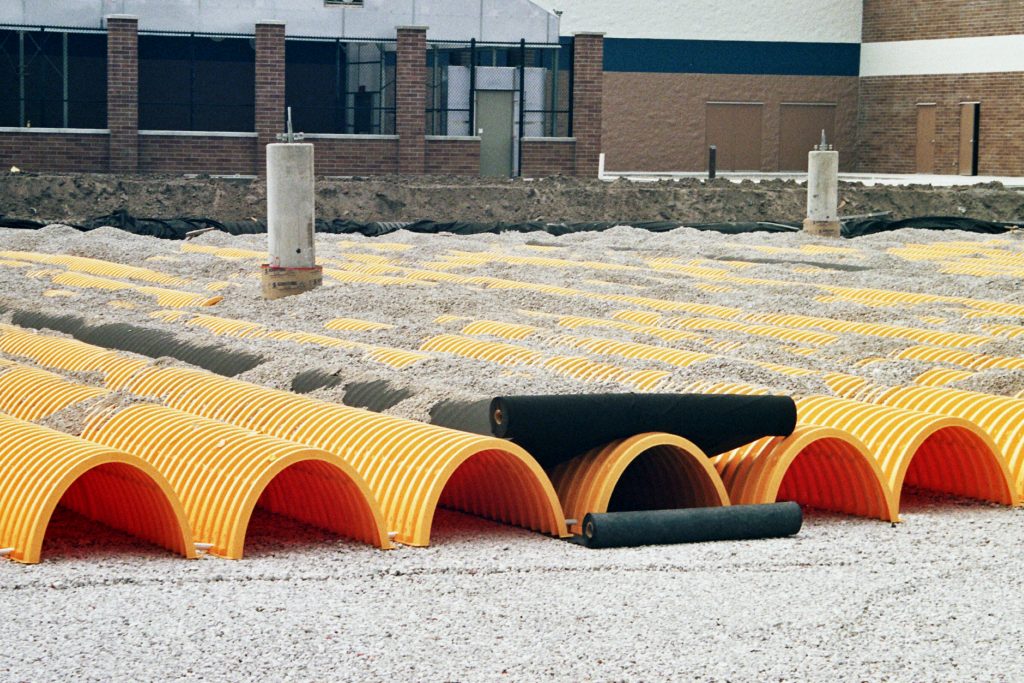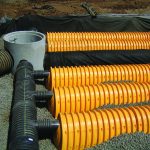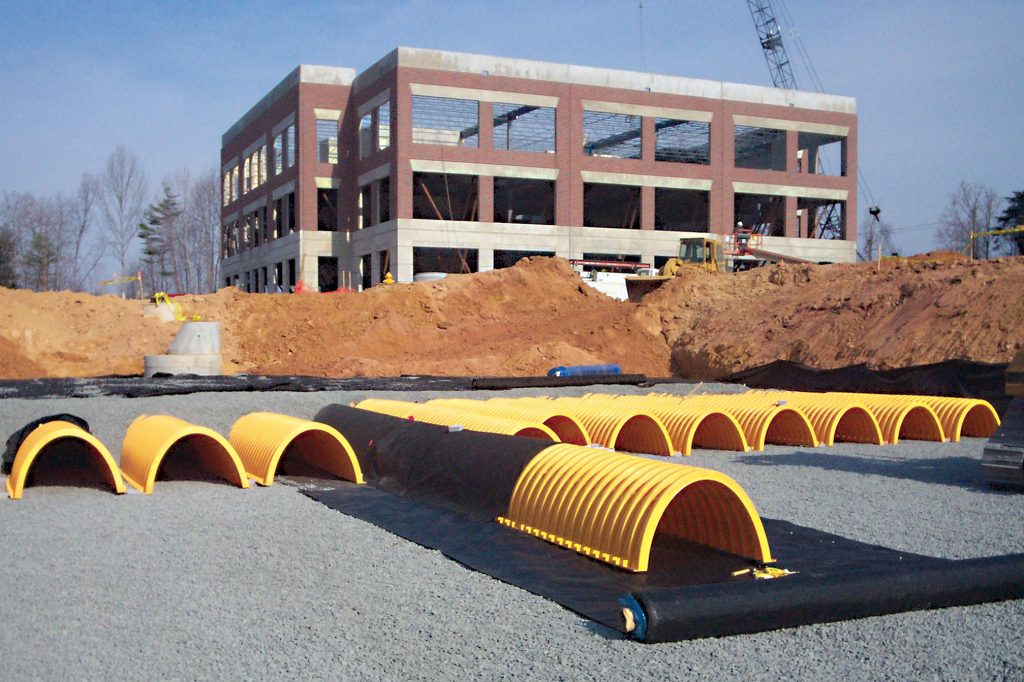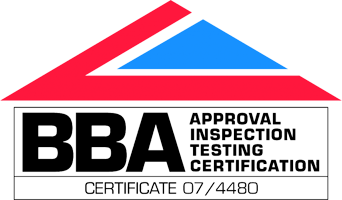Monthly Archives: November 2023
Reduce below-ground SuDS attenuation costs with ADS StormTech
Great News! ADS StormTech stands out as the sole SuDS attenuation and water quality management system with 3rd party verified Mitigation Indices (MIs), officially recognised for saving both time and money.
For detailed results, visit the British Water website.
ADS StormTech’s below-ground SuDS attenuation system uniquely meets water quality requirements for certain projects without the need for additional SuDS components in the treatment train. This translates to potential savings on both capital and maintenance costs.
The MIs for Isolator Row, the inbuilt water quality treatment device in ADS StormTech, are impressive: TSS = 0.8, Metals = 0.6, and Hydrocarbons = 0.7. These values comply with Medium pollution hazard applications per Table 26.2 of CIRIA C753 The SuDS Manual and also meet TSS requirements for High pollution hazard applications.
All results are 3rd party verified, calculated in line with The SuDS Manual and the British Water ‘How To Guide’.
To read to full article click here.
Improved solutions in stormwater management
The government’s plan for water, coupled with the implementation of Schedule 3 of the flood and Water Management Act 2010 in England, addresses concerns over wastewater discharges and the ageing sewer system in the UK.
These innovations pave the way for the inclusion of sustainable drainage systems (SuDS) as standard practice in the design, construction and adoption of new developments starting in 2024.
SuDS Treatment Train
Effective SuDS are designed to revolve around a treatment train that tackles both water quantity and quality. With various natural and engineered alternatives available, with optimum solutions balancing factors including cost, space availability, flow rates and pollutant loading.
TSS Removal
Stormwater runoff typically contains sediments, metals, hydrocarbons and nutrients. Total suspended solids (TSS), or particularly matter, are a primary factor for water treatment as they carry TSS removal is crucial for water quantity, preventing capacity reduction for storage and flow.
Isolator Row in ADS StormTech
ADS StormTech offers an underground SuDS attenuation system that offers integrated water quality management. The Isolator Row has two treatment stages, this provides gravity separation and filtrations through a geotextile fabric. Downstream StormTech chambers offer an additional treatment stage, where pollutants can absorb onto stones. This breaks down over time into non-polluting material. The Isolate Row has been tested and validated to remove over 80% of TSS, metals, hydrocarbons, phosphorus, nitrogen, and other pollutants. It’s easy to maintain using standard sewer cleaning equipment.
To find out more about Improved solutions in stormwater management read our full article here.
SuDS tips #2: Series 2. Specifying for SuDS – Part 1
There’s a choice of underground SuDS attenuation systems for new developments, each with their pros and cons. In the first article in a series of two, Stuart Crisp, UK manager of Advanced Drainage Systems, looks at large diameter pipes and crates together with the codes and standards that should be referenced in a product specification.
Large diameter pipes can be used for attenuation as a pipe laid in a single run or more commonly as a manifolded system, with pipes running in parallel lines. The most commonly used materials are concrete and plastic, although there are thin steel pipes and a hybrid product combining plastic and steel on the market.
Large diameter pipes can be a cost-effective choice of attenuation system, as long as there is sufficient available area to accommodate the volume of water that has to be stored. Where the attenuation space is beneath a public road, pipes that meet the required structural performance and highways authority requirements, can sometimes be used.
The choice of material will depend on considerations including capital cost, whole life cost taking into account maintenance and how many times a system may need replacing or upgrading and logistics requirements such as construction plant lifting capacity required and space for installation.
Pipes should be designed to BS 9295 to ensure their structural performance. Note that when pipes are laid in parallel, as is often the case for below-ground SuDS attenuation applications, a different approach to structural design is usually required compared with pipes laid as a single run.
For concrete pipes, BS EN 1916 and BS 5911-1 provide the details for product specifications. For plastic pipes, BS EN 13476 provides the details for product specifications.
| Table of Standards relevant to large diameter pipes | |
| BS 9295:2020 | Guide to the structural design of buried pipes |
| Table of Standards Relevant to Concrete large diameter pipes | |
| BS EN 1916: 2002 | Concrete pipes and fittings, unreinforced, steel fibre and reinforced |
| BS5911-1 | Concrete pipes and ancillary concrete products (recently updated to align with Eurocodes) |
| Table of Standards relevant to plastic pipes | |
| EN 13476 | Plastics piping systems for non-pressure underground drainage and sewerage – Structured-wall piping systems of unplasticised polyvinyl chloride (PVC-U), polypropylene (PP) and polyethylene (PE) |
Crates
Crates or geocellular units can be a desirable choice of attenuation system where there is limited plan area since they provide a large void space for a limited footprint. There are a variety of geocellular unit types on the market which can be used at varying depths from shallow sub-base replacement systems for car parks to deeper attenuation tanks for higher volumes of storage.
Geocellular units are typically manufactured from polypropylene (PP) or PVC by injection molding, extrusion of joining thermoformed sheets. Assessment of the performance of thermoplastics (including plastic pipes and arches) needs to take into account the influence of creep over time; creep is the tendency to deform permanently over time under a constant stress.
Structural assessments of crates must consider short-term loading such as traffic and long-term loading, such as the weight of material above the tank and lateral earth loads. Use BS EN 17150, 17151 and 17152-1, along with material tests, to determine characteristic long-term and short-term strengths and specifications.
A geotextile or geomembrane is also part of the geocellular attenuation system and therefore must be properly specified, selected and installed. Catchpits, separators and other pre-treatment measures are vital to prevent the build-up of silt and sediment within the geocellular structure. CIRIA C737 explains how the long-term volume capacity of a crate should take into account the impact of silt and sediment. The need for effective sediment management as part of a crate-based below-ground SuDS attenuation system is also emphasized in CIRIA C753 The SuDS Manual.
| Table of Standards relevant to crates | |
| CIRIA C737 | Structural and geotechnical design of modular geocellular drainage systems |
| BS EN17152-1 | Plastics piping systems for non-pressure underground conveyance and storage of non-potable water – Boxes used for infiltration, attenuation and storage systems Part 1: Specifications for storm water boxes made of PP and PVC-U |
Stuart Crisp is UK Manager for Advanced Drainage Systems (ADS). ADS is America’s largest manufacturer of thermoplastic corrugated drainage pipes and a specialist in water management systems. StormTech has a long and successful track record with over 50,000 below ground SuDS attenuation system installations using in excess of 3m units.
Originally published in Water magazine October 2023


Three is the Magic Number
Stuart Crisp, UK manager of Advanced Drainage Systems (ADS), looks at looming legislation which will mandate SuDS and their adoption will require new skills for developers and designers.

In January 2023, the Government announced plans to finally implement Schedule 3 of the Flood and Water Management Act 2010, which will make the adoption of SuDS mandatory in England, as it has been in Wales since 2019. This is a game-changer for SuDS.
While developers currently have the right to connect drainage systems into sewers, that is unlikely to be the case anymore, without prior justification and consent.

Instead, they will have to show that they have included SuDS in their schemes and demonstrate how that SuDS system can be maintained over the lifetime of a development.
Subject to a consultation later this year, implementation of Schedule 3, which includes SuDS approval and adoption, is expected in late 2024. This means that there is less than two years for concerned professionals to get up to speed with the range and implications of possible solutions, both above and below ground.
Designers will have to think about more than just hydraulic design, to include whole life maintenance and treatment train to deal with water quality issues and specific pollutants. There will probably be a transition period as Schedule 3 comes in, but it makes sense to upskill now in order to future-proof designs.
Currently, SuDS can be adopted by water companies as long as systems comply with the Design and Construction Guidance (DCG) which sets out how SuDS should be delivered. However, it is not compulsory for a developer to jump through the adoption hoops. The end result is that some assets that do meet prescribed and consistent standards of quality and performance, may not be properly maintained and consequently there are problems down the line.
DCG was updated last year to include arch-shaped below-ground attenuation structures. One such system offers a flexible and cost-efficient alternative to other below-ground attenuation structures such as crates or large-diameter pipes, with the benefit of built-in stormwater quality management, reducing the extent of additional treatment required elsewhere in the SuDS system.

It is expected that Schedule 3 will change the assessment and adoption of SuDS to become SuDS approving bodies (SABs) which will be within unitary councils or county councils. And it will bring in new statutory guidance, taking over from DCG to cover design, construction and operation over an asset’s lifetime.
The statutory requirements in England may be more onerous than both DCG and the current non-statutory standards in terms of what will be acceptable for planning approval and adoption after construction. SuDS adoption becoming mandatory, with few exceptions, will raise the bar. Happily, poor quality products and poorly executed designs are likely to be challenged and disappear from the market.
For anyone looking to start the upskilling process now, training and CPDs are already available from some manufacturers and should include information on legislation, best practice and comparable systems.
For more information on Advanced Drainage Systems, visit www.adspipe.co.uk.

SuDS: Maintenance Matters
Designers need a better understanding of the maintenance requirements of different SuDS components to ensure that the systems they design will perform as intended. Stuart Crisp, UK manager at Advanced Drainage Systems (ADS), reports.
The issue of SuDS maintenance has always been a thorny one. Research suggests that the question of who will be responsible for the maintenance, and the cost of it, has been a prime factor in their slow uptake in the United Kingdom.
With the Government’s intention to implement Schedule 3 of the Flood and Water Management Act 2010 (FWMA) in England, making the installation and adoption of SuDS mandatory, concerns over maintenance issues again come to the fore. Developers, designers and installers need to understand the maintenance implications for alternative solutions considered for a project (in addition to, for example, hydraulic performance, structural integrity and water quality) and then offered to the adopting body responsible for the long-term operation of the SuDS asset. For underground attenuation devices, these vary significantly.
The more onerous the maintenance requirements, the higher the risk of them not being properly executed. The impacts of poor maintenance regimes and difficult-to-clean systems can be significant, increasing the risk of blockages – leading to loss of capacity and flooding – and pollutants washing out into water bodies.
Guidance
The SuDS Manual, CIRIA C753, recognizes that underground attenuation crates are ‘difficult to clean’ and that their capacity will reduce over time. Section 21.5.3 of the manual recommends that the size of crates should be increased by 10% to allow for accumulation of sediment. This applies even when a maintenance programme is deployed, since it isn’t always possible to remove all sediment during cleaning. Commercial developments, high density residential development, car parks and highways face the highest potential loss of storage, according to the guidance.

For both crates and large diameter pipes, some form of silt separation and removal system upstream is normally required to slow down the rate of sediment build-up and to remove some of the pollutants that cling to those particles. These upstream components must also be inspected and cleaned at intervals prescribed in a SuDS maintenance plan.
In designing its StormTech underground attenuation device, ADS sought to remove the need for costly upstream pre-treatment. An inbuilt ‘Isolator Row’ – essentially a modified version of the standard StormTech elliptical arches – collects the sediment before the water moves into the main body of the system.
Independent tests have demonstrated that the Isolator Row removes over 80% of total suspended solids (TSS), together with the metals, hydrocarbons, phosphorus, nitrogen, and other surface water pollutants that cling to them. The Isolator Row is easily accessed via a closely located manhole, and can be cleaned out with standard sewer-cleaning equipment.
Natural SuDS need maintenance too
Natural SuDS, as well as engineered ones, also need regular and planned maintenance. These range from frequent interventions such as litter picking and inspection of inlets and outlets to more occasional and seasonal activities such as vegetation management and removal of silt build-up.
Again, failure to maintain natural attenuation components such as ponds can have negative impacts. A 2018 study of SuDS in East Kilbride by the University of Glasgow, published in The Glasgow Naturalist, found that pollutants in some SuDS ponds were hindering amphibian breeding and development and that more frequent monitoring and management would be wise.
Whether natural or engineered SuDS, or a combination, maintenance regimes and their associated cost, should not be a barrier to their implementation. However, it is important that maintenance issues are understood, planned and communicated at the earliest stages of a project.
For more information on Advanced Drainage Systems, visit www.adspipe.co.uk.



